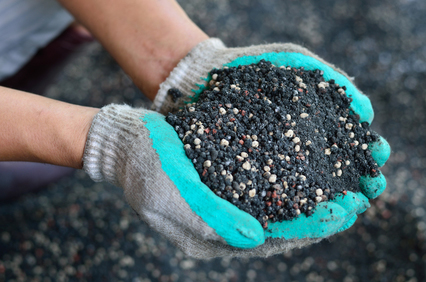Managing your soil drainage can mean the difference between a bountiful crop of healthy, vibrant plants and average or sickly vegetation. Soil drainage management requires the proper mix of water, aeration, and nutrients.
The natural drainage tendencies of any garden soil can be tested by digging a hole the size of a gallon jug. Fill the hole with water and check back at intervals to see how much water remains after one, two and four hours. Ideally, complete drainage should occur within two to four hours. This is the guideline to strive for after altering your garden soil for better drainage.
Treating Sandy Garden Soil
Soil that drains too quickly contains a higher concentration of sand. The addition of organic materials, such as compost, will help slow the drainage rate and allow the soil to retain nutrients longer. Plants that grow well in fast-draining, sandy soils are onions, carrots, apples, tomatoes and salad greens. Sandy soil will need more frequent watering and fertilizing. It’s also a good idea to put a 3″ layer of mulch around your plants to help retain water and minimize weeds.
Treating Clay Garden Soil
Slow-draining soil contains a large amount of clay that traps water. This type of soil holds nutrients well, but does not allow for adequate drainage and aeration. Sand, coir, peat, and vermiculite can all be added to clay garden soils to fix drainage and aeration problems. Plants that are well suited for clay soils are roses, squash, parsley, and dogwoods.
Altering Garden Soil Texture
A good combination to strive for when altering your garden soil texture is 25% clay, 25% organic material, and 50% sand. This provides a nice loamy textured soil with adequate drainage, aeration, and nutrients for optimal plant growth.
Landscaping for Optimal Drainage
Landscaping can help promote proper drainage in garden soil. Grading the soil to provide a gentle slope encourages excess water to drain through the soil without washing soil and nutrients from the plant’s root systems. If your topsoil is washing away after a heavy rain, landscaping timbers can be utilized to raise the garden bed and add adequate soil support. If your garden is developing puddles of standing water after a rainfall, grading the soil into a gentle slope can help your plants retain the proper amount of moisture.
Timing Your Tilling
Tilling in the spring is a common garden practice. The smell of freshly turned earth in the spring is a tradition and source of great joy for many gardeners. If your garden requires treatment for improved drainage, plowing in the fall may be the answer to your problems.
Why Plow in the Fall?
Fall plowing exposes the deeper soil to the repeated freezing and thawing that takes place during winter and spring. This process breaks up heavy clays, kills off excessive bacteria and pests, and leaves the garden soil porous and in better draining condition than the previous growing season.
Soil drainage management is an ongoing process for gardeners. Proper soil drainage is one of the most important maintenance tasks of any gardener. Try these drainage tips to give your plants the moisture they long for. The perfect soil may be elusive, but the process of improving soil drainage benefits both the vegetation and the gardener.
Back to our home page

